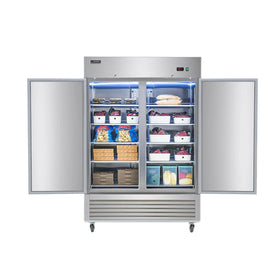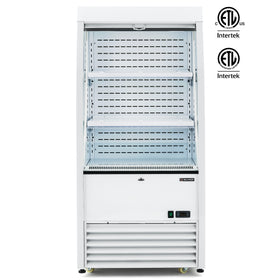If you’ve already decided your business needs a commercial convection oven, you’ve taken a big step in the right direction. But here’s where many business owners get stuck: not all convection ovens are the same, and sometimes, the differences may not be so obvious.
The right oven for a bakery isn’t necessarily the best one for a high-volume café or pizzeria. Knowing the different types of convection ovens and how each fits specific needs can help you avoid overspending, save energy, and make your kitchen run more efficiently.

The Different Types of Commercial Convection Ovens
Commercial convection ovens can be classified by power source (gas or electric convection ovens), structure (deck, countertop, or floor convection ovens), and purpose (such as pizza ovens, bread ovens, or general baking ovens).
Each of these convection oven types determines the overall cost, performance, and the kind of products you can bake effectively in a different way.
1. Countertop Convection Ovens
Countertop convection ovens are the smallest commercial convection oven type, and they are most common in small bakeries, cafes, coffee shops, and catering businesses where space is limited and/or production is not too heavy.
-
You can expect a 1/4 Pan Countertop Convection Oven to offer about 0.9 cu. Ft. capacity. They also easily fit on prep tables or counters and typically have one or two racks.
-
A countertop convection oven is best for pastries, cookies, reheating baked goods, and small batches of bread or roasted items.
Countertop models are inexpensive, easy to maintain, and ideal for operations where speed and space are top priorities rather than mass production.
2. Floor or Full-Size Commercial Convection Ovens
Floor commercial ovens are larger, freestanding units capable of handling high production volumes.
They typically come with double, triple, or even multiple decks or racks, and due to their increased size and capacity, are perfect for baking breads, pastries, large batches of roasts, casseroles, and multi-tray baking.
If you run a high-volume bakery, restaurant, hotel, or commercial kitchen, a floor commercial convection oven should be at the top of your priority list.
They are excellent for businesses that bake or cook continuously throughout the day. These ovens offer better airflow control and durability but come at a higher upfront cost.

3. Deck Convection Ovens
Commercial deck convection ovens feature multiple baking decks, often with independent controls for temperature and airflow. They combine convection technology with the baking characteristics of a deck oven, and they are known for the radiant heat they produce as well as the crisp crusts.
A deck oven offers more even baking and flexibility, but takes up more space and usually costs more than single-chamber ovens, which is why they are ideal for pizzerias, artisan bakeries, and pastry shops.
Consider a single-deck oven or double-deck model based on the demands of your business, i.e, the volume of pizza, artisan loaves, croissants, and specialty baked goods that
4. Purpose-Specific Convection Ovens (Pizza, Bread, Combination Ovens)
-
Pizza convection ovens: Designed for high heat and fast turnover. They balance airflow and deck heat to achieve that perfect crisp without burning the toppings.
-
Bread convection ovens: Offer more moisture control and programmable settings for proofing and baking cycles.
-
Combination convection ovens (Combi ovens): Allow you to bake, steam, roast, and reheat-all in one unit.

Gas vs. Electric Convection Ovens
Another important consideration you have to make when choosing the best commercial oven for your business is whether to go for a gas convection oven or an electric convection oven. Obviously, the key consideration for choosing between the two would be which one is more readily available and affordable to you.
However, there are several implications for choosing a gas oven over an electric oven or vice versa, especially when you are working on a commercial scale:
1. Energy Efficiency and Operating Costs
-
Gas convection ovens heat up faster and are often cheaper to operate in areas where gas is less expensive than electricity.
-
Electric ovens tend to offer better temperature precision and consistency, making them ideal for delicate baked goods.
2. Installation and Maintenance
-
Gas ovens require proper ventilation, gas line installation, and more frequent maintenance checks.
-
Electric ovens are simpler to install (just plug in and bake), but they may increase your electrical load.
3. Heat and Kitchen Comfort
-
Gas ovens produce more ambient heat, which can make the kitchen hotter.
-
Electric ovens generate less external heat and are often quieter in operation.
4. Product Performance
-
Gas: Better for roasting meats, pizzas, and hearty breads needing strong bottom heat.
-
Electric: Preferred for pastries, cakes, and anything requiring precise, even temperatures.

Gas vs Electric Ovens: Main Differences in Commercial Settings
|
Feature / Aspect |
Gas Convection Oven |
Electric Convection Oven |
|
Energy Efficiency and Operating Costs |
Heats up faster; often cheaper to operate where gas is less expensive |
Better temperature precision and consistency; ideal for delicate baked goods |
|
Installation and Maintenance |
Requires proper ventilation, gas line installation, and more frequent maintenance |
Simple installation (plug-in); may increase electrical load |
|
Heat and Kitchen Comfort |
Produces more ambient heat, making the kitchen hotter |
Generates less external heat; quieter operation |
|
Product Performance |
Better for roasting meats, pizzas, and hearty breads needing strong bottom heat |
Preferred for pastries, cakes, and items requiring precise, even temperatures |
How to Choose the Best Convection Oven for Your Business
When choosing between different convection ovens, consider:
1. Your Menu: What are you baking or roasting most often?
-
Bakeries benefit from deck or electric floor models for even, gentle baking.
-
Pizzerias thrive with gas deck ovens for crisp crusts and fast turnover.
-
Cafés and small shops often do best with compact electric countertop ovens.
2. Your Production Volume: Match oven size and rack capacity to your busiest hours. Overbuying wastes money and energy; underbuying slows your operation.
3. Available Space and Layout: Measure carefully. A floor model may not fit in a tight kitchen, especially if ventilation is limited.
4. Energy and Utility Costs: Check local gas and electricity rates. In some regions, one may significantly outcost the other.
5. Budget and Maintenance: Remember: cheaper isn’t always better. A reliable, energy-efficient oven pays off in reduced downtime, fewer repairs, and consistent product quality.
Best Convection Oven For Business: Which Convection Oven Fits Your Business?
|
Business Type |
Recommended Oven Type |
Power Source |
Key Advantages |
|
Small café/bakery |
Countertop convection oven |
Electric |
Compact, affordable, precise for small batches |
|
Mid-size bakery/restaurant |
Floor convection oven |
Electric or gas |
High volume, consistent airflow, multiple racks |
|
Pizzeria |
Deck convection oven or pizza convection oven |
Gas |
Fast heat recovery, crisp crusts |
|
Artisan bakery |
Deck convection oven |
Electric |
Even baking, moisture control for crusty loaves |
|
Multi-menu kitchen/hotel |
Combination convection oven |
Electric |
Versatile – bake, roast, and steam in one unit |
|
Catering or food truck |
Countertop convection oven |
Electric |
Portable, fast preheat, minimal setup |
Final Thoughts
Choosing a convection oven is not just about picking a brand or chasing a sale: it’s about finding the right fit for how your kitchen operates.
By understanding the different types, their strengths, and how they align with your menu and business goals, you can make a decision that saves money, energy, and stress in the long run.










